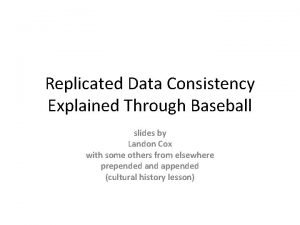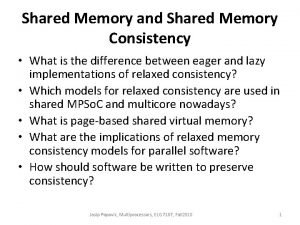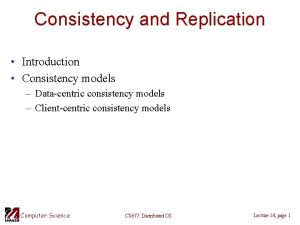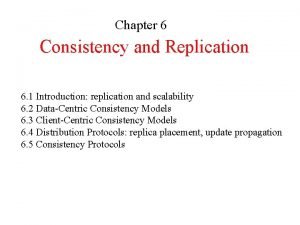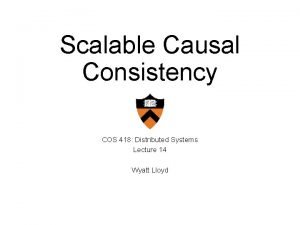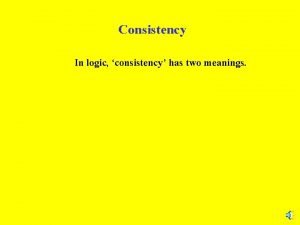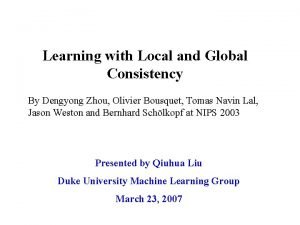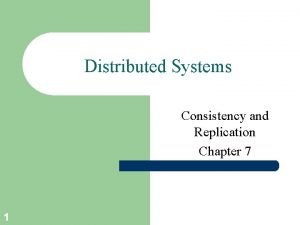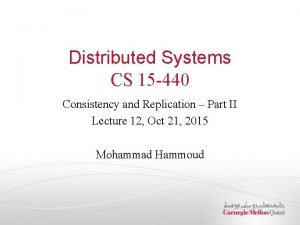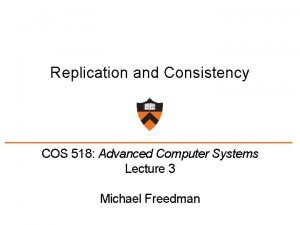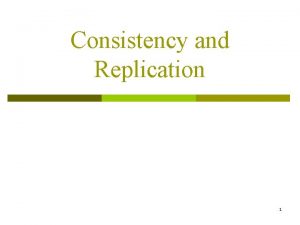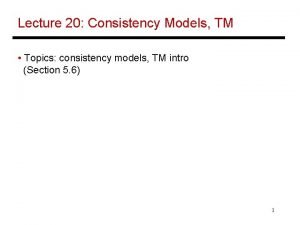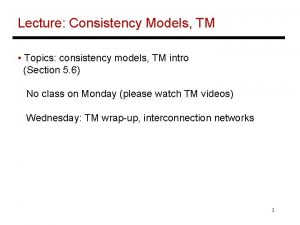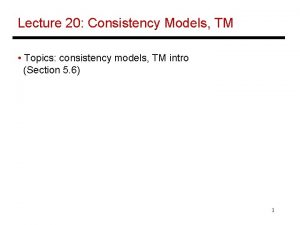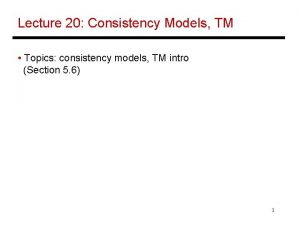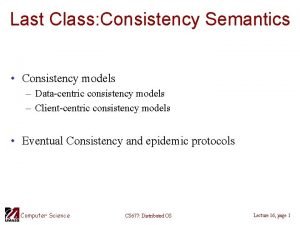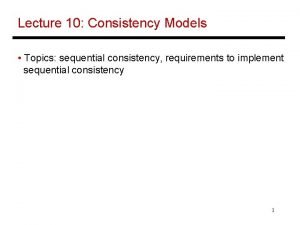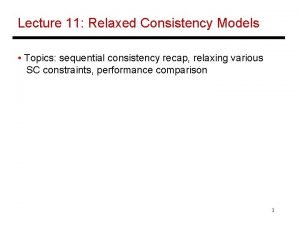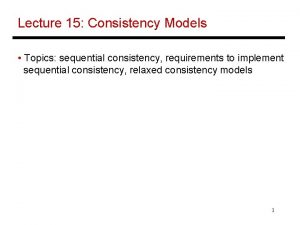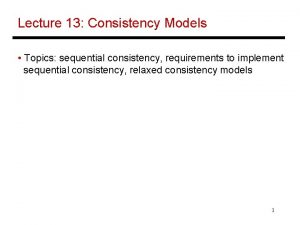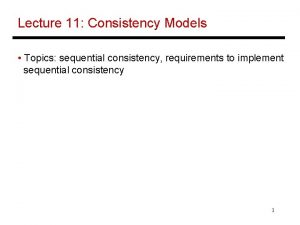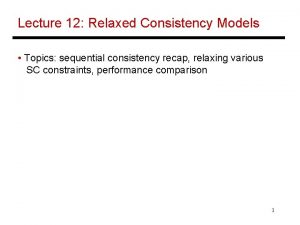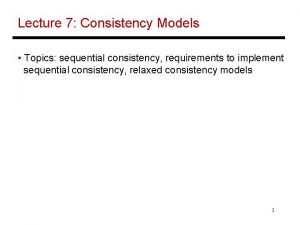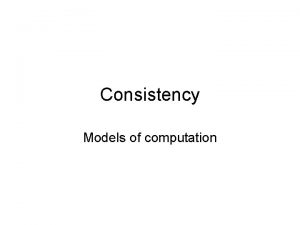Lecture Consistency Models TM Topics consistency models TM

















![Example Hash table implementation transaction begin index = hash(key); head = bucket[index]; traverse linked Example Hash table implementation transaction begin index = hash(key); head = bucket[index]; traverse linked](https://slidetodoc.com/presentation_image_h2/4fa3e54ca8035662405f3f3cf84cb856/image-18.jpg)










- Slides: 28

Lecture: Consistency Models, TM • Topics: consistency models, TM intro (Section 5. 6) No class on Monday (please watch TM videos) Wednesday: TM wrap-up, interconnection networks 1

Coherence Vs. Consistency • Recall that coherence guarantees (i) that a write will eventually be seen by other processors, and (ii) write serialization (all processors see writes to the same location in the same order) • The consistency model defines the ordering of writes and reads to different memory locations – the hardware guarantees a certain consistency model and the programmer attempts to write correct programs with those assumptions 2

Example Programs Initially, Head = Data = 0 Initially, A = B = 0 P 1 A=1 if (B == 0) critical section P 2 B=1 if (A == 0) critical section P 1 Data = 2000 Head = 1 P 2 while (Head == 0) {} … = Data Initially, A = B = 0 P 1 A=1 P 2 P 3 if (A == 1) B=1 if (B == 1) register = A 3

Sequential Consistency P 1 Instr-a Instr-b Instr-c Instr-d … P 2 Instr-A Instr-B Instr-C Instr-D … We assume: • Within a program, program order is preserved • Each instruction executes atomically • Instructions from different threads can be interleaved arbitrarily Valid executions: ab. Ac. BCDde. E… or ABCDEFab. Gc… or abc. Ad. Be… or a. Ab. Bc. Cd. De. E… or …. . 4

Problem 1 • What are possible outputs for the program below? Assume x=y=0 at the start of the program Thread 1 x = 10 y = x+y Print y Thread 2 y=20 x = y+x 5

Problem 1 • What are possible outputs for the program below? Assume x=y=0 at the start of the program Thread 1 A x = 10 B y = x+y C Print y Thread 2 a y=20 b x = y+x Possible scenarios: 5 choose 2 = 10 ABCab ABa. Cb ABab. C Aa. BCb Aa. Bb. C 10 20 20 30 30 Aab. BC a. ABCb a. ABb. C a. Ab. BC ab. ABC 50 30 30 50 30 6

Sequential Consistency • Programmers assume SC; makes it much easier to reason about program behavior • Hardware innovations can disrupt the SC model • For example, if we assume write buffers, or out-of-order execution, or if we drop ACKS in the coherence protocol, the previous programs yield unexpected outputs 7

Consistency Example - I • An ooo core will see no dependence between instructions dealing with A and instructions dealing with B; those operations can therefore be re-ordered; this is fine for a single thread, but not for multiple threads Initially A = B = 0 P 1 P 2 A 1 B 1 … … if (B == 0) if (A == 0) Crit. Section The consistency model lets the programmer know what assumptions 8 they can make about the hardware’s reordering capabilities

Consistency Example - 2 Initially, A = B = 0 P 1 A=1 P 2 P 3 if (A == 1) B=1 if (B == 1) register = A If a coherence invalidation didn’t require ACKs, we can’t confirm that everyone has seen the value of A. 9

Sequential Consistency • A multiprocessor is sequentially consistent if the result of the execution is achieveable by maintaining program order within a processor and interleaving accesses by different processors in an arbitrary fashion • Can implement sequential consistency by requiring the following: program order, write serialization, everyone has seen an update before a value is read – very intuitive for the programmer, but extremely slow • This is very slow… alternatives: Ø Add optimizations to the hardware Ø Offer a relaxed memory consistency model and fences 10

Relaxed Consistency Models • We want an intuitive programming model (such as sequential consistency) and we want high performance • We care about data races and re-ordering constraints for some parts of the program and not for others – hence, we will relax some of the constraints for sequential consistency for most of the program, but enforce them for specific portions of the code • Fence instructions are special instructions that require all previous memory accesses to complete before proceeding (sequential consistency) 11

Fences P 1 { P 2 { Region of code with no races } } Fence Acquire_lock Fence { { Racy code } Fence Release_lock Fence 12

Lock Vs. Optimistic Concurrency lockit: LL R 2, 0(R 1) BNEZ R 2, lockit DADDUI R 2, R 0, #1 SC R 2, 0(R 1) BEQZ R 2, lockit Critical Section ST 0(R 1), #0 tryagain: LL R 2, 0(R 1) DADDUI R 2, R 3 SC R 2, 0(R 1) BEQZ R 2, tryagain LL-SC is being used to figure out if we were able to acquire the lock without anyone interfering – we then enter the critical section If the critical section only involves one memory location, the critical section can be captured within the LL-SC – instead of spinning on the lock acquire, you may now be spinning trying to atomically execute the CS 13

Transactions • New paradigm to simplify programming § instead of lock-unlock, use transaction begin-end § locks are blocking, transactions execute speculatively in the hope that there will be no conflicts • Can yield better performance; Eliminates deadlocks • Programmer can freely encapsulate code sections within transactions and not worry about the impact on performance and correctness (for the most part) • Programmer specifies the code sections they’d like to see execute atomically – the hardware takes care of the rest (provides illusion of atomicity) 14

TM Overview 15

Transactions • Transactional semantics: § when a transaction executes, it is as if the rest of the system is suspended and the transaction is in isolation § the reads and writes of a transaction happen as if they are all a single atomic operation § if the above conditions are not met, the transaction fails to commit (abort) and tries again transaction begin read shared variables arithmetic write shared variables transaction end 16

Example Producer-consumer relationships – producers place tasks at the tail of a work-queue and consumers pull tasks out of the head Enqueue transaction begin if (tail == NULL) update head and tail else update tail transaction end Dequeue transaction begin if (head->next == NULL) update head and tail else update head transaction end With locks, neither thread can proceed in parallel since head/tail may be updated – with transactions, enqueue and dequeue can proceed in parallel – transactions will be aborted only if the queue is nearly empty 17
![Example Hash table implementation transaction begin index hashkey head bucketindex traverse linked Example Hash table implementation transaction begin index = hash(key); head = bucket[index]; traverse linked](https://slidetodoc.com/presentation_image_h2/4fa3e54ca8035662405f3f3cf84cb856/image-18.jpg)
Example Hash table implementation transaction begin index = hash(key); head = bucket[index]; traverse linked list until key matches perform operations transaction end Most operations will likely not conflict transactions proceed in parallel Coarse-grain lock serialize all operations Fine-grained locks (one for each bucket) more complexity, more storage, concurrent reads not allowed, concurrent writes to different elements not allowed 18

TM Implementation Core Cache • Caches track read-sets and write-sets • Writes are made visible only at the end of the transaction • At transaction commit, make your writes visible; others may abort 19

Detecting Conflicts – Basic Implementation • Writes can be cached (can’t be written to memory) – if the block needs to be evicted, flag an overflow (abort transaction for now) – on an abort, invalidate the written cache lines • Keep track of read-set and write-set (bits in the cache) for each transaction • When another transaction commits, compare its write set with your own read set – a match causes an abort • At transaction end, express intent to commit, broadcast write-set (transactions can commit in parallel if their write-sets do not intersect) 20

Summary of TM Benefits • As easy to program as coarse-grain locks • Performance similar to fine-grain locks • Speculative parallelization • Avoids deadlock • Resilient to faults 21

Design Space • Data Versioning § Eager: based on an undo log § Lazy: based on a write buffer • Conflict Detection § Optimistic detection: check for conflicts at commit time (proceed optimistically thru transaction) § Pessimistic detection: every read/write checks for conflicts (reduces work during commit) 22

“Lazy” Implementation • An implementation for a small-scale multiprocessor with a snooping-based protocol • Lazy versioning and lazy conflict detection • Does not allow transactions to commit in parallel 23

“Lazy” Implementation • When a transaction issues a read, fetch the block in read-only mode (if not already in cache) and set the rd-bit for that cache line • When a transaction issues a write, fetch that block in read-only mode (if not already in cache), set the wr-bit for that cache line and make changes in cache • If a line with wr-bit set is evicted, the transaction must be aborted (or must rely on some software mechanism to handle saving overflowed data) 24

“Lazy” Implementation • When a transaction reaches its end, it must now make its writes permanent • A central arbiter is contacted (easy on a bus-based system), the winning transaction holds on to the bus until all written cache line addresses are broadcasted (this is the commit) (need not do a writeback until the line is evicted – must simply invalidate other readers of these cache lines) • When another transaction (that has not yet begun to commit) sees an invalidation for a line in its rd-set, it realizes its lack of atomicity and aborts (clears its rd- and wr-bits and re-starts) 25

“Lazy” Implementation • Lazy versioning: changes are made locally – the “master copy” is updated only at the end of the transaction • Lazy conflict detection: we are checking for conflicts only when one of the transactions reaches its end • Aborts are quick (must just clear bits in cache, flush pipeline and reinstate a register checkpoint) • Commit is slow (must check for conflicts, all the coherence operations for writes are deferred until transaction end) • No fear of deadlock/livelock – the first transaction to acquire the bus will commit successfully • Starvation is possible – need additional mechanisms 26

“Lazy” Implementation – Parallel Commits • Writes cannot be rolled back – hence, before allowing two transactions to commit in parallel, we must ensure that they do not conflict with each other • One possible implementation: the central arbiter can collect signatures from each committing transaction (a compressed representation of all touched addresses) • Arbiter does not grant commit permissions if it detects a possible conflict with the rd-wr-sets of transactions that are in the process of committing • The “lazy” design can also work with directory protocols 27

Title • Bullet 28
 Bitcoin
Bitcoin 01:640:244 lecture notes - lecture 15: plat, idah, farad
01:640:244 lecture notes - lecture 15: plat, idah, farad Client centric consistency model
Client centric consistency model Intel processor
Intel processor Client-centric consistency models
Client-centric consistency models Shared memory consistency models a tutorial
Shared memory consistency models a tutorial What is the difference between models and semi modals
What is the difference between models and semi modals Explain data centric consistency model
Explain data centric consistency model Explain data centric consistency model
Explain data centric consistency model Causal consistency
Causal consistency Consistency in logic
Consistency in logic Strict consistency
Strict consistency Overall consistency
Overall consistency Dengyong zhou
Dengyong zhou Nache design
Nache design Arc consistency sudoku
Arc consistency sudoku Goods-services continuum
Goods-services continuum It is the appearance and feel of a surface
It is the appearance and feel of a surface Distributed data store
Distributed data store Explain data centric consistency model
Explain data centric consistency model Spss cronbach's alpha
Spss cronbach's alpha A candy manufacturer wants to test consistency
A candy manufacturer wants to test consistency A liaison is a thickener made from a mixture of *
A liaison is a thickener made from a mixture of * Db
Db Casual consistency
Casual consistency Strategic consistency triangle
Strategic consistency triangle Strict consistency
Strict consistency What is verb tense consistency
What is verb tense consistency Consistency is an underappreciated
Consistency is an underappreciated
